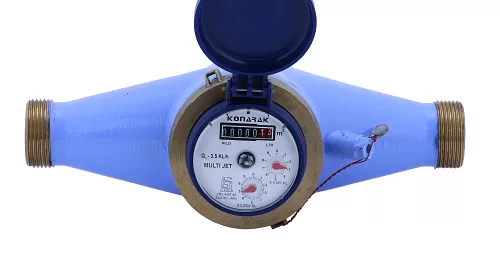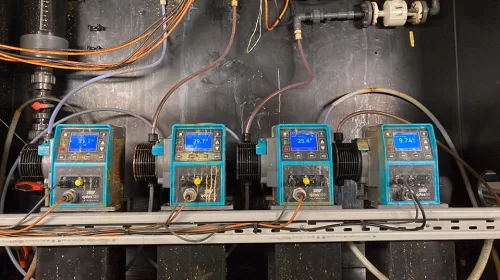By Dr. Jagjit Singh Sehra, President, CST Associates
In the last edition of EA Water, the author presented some on idea how much water is being wasted in the cooling towers of thermal power plants. It was also mentioned that if we save this water how farmers can earn Rs. 3,315 crores per year. In this article we will discuss, how we can convert the existing thermal power stations, to save 80% of the water. To understand the same first we need to understand how much water is evaporated in a cooling tower & what are the technologies by which we can save this great loss.
How to save 80% of the water in cooling towers of Thermal Power Stations?
We already discussed, Open Cycle Forced Draft Cooling Towers in the last article. In this kind of cooling tower, there is no way we can save the loss of evaporated water with present technology. But there is a way to save this water by using two types of towers. These towers are known as Dry Cooling Towers and Adiabatic Cooling Towers. Let us understand the difference between the two. As the name indicates it is a dry system where the process water flows in a closed-loop cooling tower. The process water is not exposed to the ambient air. These type of cooling towers works purely on the approach principle. This is usually referred to as Delta Approach. The formula for the same is Delta Approach = Process water out of the dry cooler – Ambient Air into the DCT. Minimum Delta A required for the dry cooling towers has to be in between 3 ~ 5 Deg. C. The higher the approach lower is the surface area required for the heat exchanger and vice-versa. Since air is the only cooling media in the dry cooler, therefore delta approach cannot be in minus sign. For Example, if the incoming water to the dry cooler at 70 Deg. C. and the ambient air is at 45 Deg. C. The water outlet from the dry cooler will be in the range of 48 to 50 Deg. C.. Which Correspondence to the formula of Delta A. This can never be 44 Deg. C. or less. This will also not be ever 45 Deg. C. even if we select the world’s most efficient finned surface heat exchanger. This is because of metal resistance in between air blowing outside and flowing water inside the tubes of the heat exchanger. Dry cooling towers are not sensitive to the inlet humidity of the tower. The humidity can vary from 90 to 99%. This works on the dry-bulb condition and is a purely sensible load heat exchanger. If we want to achieve process water temperature less then ambient air then we need to add an Adiabatic System to the dry cooling tower. Adiabatic Cooling Tower (ACT): In the adiabatic cooling towers, the incoming air is being cooled first, before it enters the dry cooling tower. We can understand the concept by an example. Let us study a situation where the ambient temperature reaches 45 Deg. C. and the water outlet from the cooling tower required is 32 Deg. C., Delta A= 32-45 = -13 Deg. C. and further to achieve 32 Deg. C., Delta A has to be minimum 3 Deg. C. In such a case the adiabatic system is installed in the front of the dry cooler that brings the air temperature from 45 to 29 Deg. C., in the first stage. This is 16 Deg. C. less than the entering ambient air. It has been observed that in many cases when dry bulb (DB) temperature reaches 45 Deg. C., the relative humidity level is around 10 ~ 15%. The reduction of 16 Deg. C. is such a case is very much possible. This is because of the reason that air still has 90 to 85% humidity absorbing capacity before it becomes saturated. The hot air entering the adiabatic system transmits its heat to the media of cooling (Which is water in this case) and the air starts approaching the point of saturation and thus the entering DB temperature reduces up. There are many methods that have been adopted by companies across the globe.
Direct Water Spraying: In such a system, water is made to pass through the fine nozzles. This creates mist effect in the front of the finned surface heat exchanger. To avoid water spilling out a cover of fine mesh is provided. There are many limitations to the system. The biggest problem is that if the quality of water is not maintained as per the manufacturer’s recommendation the salt starts depositing on the surface of the finned surface heat exchanger and in few days the heat exchanger gets chocked and does not carry any kind of heat transfer. Therefore the system fails in a few months of installations. The author has observed failures of many installations where this kind of heat exchangers have been installed.
Fogging Systems: In this system, the water is made to pass through a fog generating system. The fog is nothing but, a saturated air. When it interacts with the incoming high temperature and low humidity air, the cooling effects occur. This kind of system is better than the mist spraying system. As in this system, there are no water droplets. But this has one very great limitation. This is that when ambient wind velocity becomes more than the designed air velocity of the heat exchanger the fog starts flowing in the opposite direction. Hence the system fails. In this system, the quality of water is also a very big concern. If the water quality is not maintained then there are frequent chocking of water filters increases and the mist does not happen. This kind of system should also be avoided. We can see many failures of such systems installed.
Evaporating Pads made up of Papers: In such system evaporative pads are being used that are manufactured out of paper. These pads are in the shape of a honeycomb. The pads absorb the water very well and transmit the cold air without mist or the salt to the heat exchanger. This system works very effectively for one or two years. These pads need to be changed every now and then. Thus incurring a great expense. This is not very good for power plants as the equipment has to work for nearly twenty years.
Evaporating Pads made of Plastics: The system is similar as discussed in point 3) the only difference is that instead of paper the media of the pads is plastics. This system takes care of all the points discussed above. These pads are very rigid even if these pads becomes dirty it can be cleaned by high jet water spray systems. The only limitation is that these are not as efficient as the paper pad systems. But if we carefully select the thickness of the pad it can surely achieve the desired results.
Connecting Adiabatic Cooling Towers to the existing Thermal Power Plants? Since most of the thermal power plants have cooling towers. So it is very easy to install the Adiabatic Cooling Tower in Parallel to the cooling tower. All we need is to install a three-way valve on the water inlet and outlet of the cooling tower and adiabatic systems. This also serves as double safety. It means whenever there is some maintenance issue in the adiabatic cooling tower, the water can be diverted to the cooling tower on a temporary basis. This can be done while the plant is already in running position.
Power and Water Consumption of Adiabatic Cooling Towers. In figure #5, one can see clearly how much water and power are consumed while running the thermal power stations. For example, for 100 MW thermal power plants when we use opencycle cooling towers the water consumption is 290 Cubic Meters per hour and power consumed by fans is 86.30 KW. Whereas when an Adiabatic Cooling Towers are used the water consumption is reduced to 58.00 CMH & power consumption increases to 213.70 KW. If we see the total power increased when compared to the extra power used, it comes to .21%. Which is negligible, when compared to the water saved.
Benefits of using Adiabatic Cooling Towers over Air Cooled Condensers:- One of the methods, that is very popular, to eliminate 100% of the water is to install the Air Cooled Condenser (ACC). In ACC steam is directly cooled with the ambient air. There are many limitation of this system also. The steam comes out of the turbine at very low pressure and low temperature. Usually, the condensers are selected at 40 Deg.C ambient. When Ambient temperature goes beyond the designed temperature, the power plant capacity has to be reduced to avoid back pressure on the turbine. Due to this power plants goes into deration mode and there is a huge loss of power production. When we use the Adiabatic Cooling Towers are used instead of ACC, power plants runs on the fully capacity. This is because of the reason that we get constant water outlet temperature from the Adiabatic Coolers. Also, the biggest benefit is that there is no scale formation as the water moves in the close circuit. The future of thermal power plants is to go in for Adiabatic Technology which is the most powerful and practical solution. Investment and Foot Prints Required Cost of equipment, pay back period, foot print and how the investment required funds will be discuss in the next month article.





